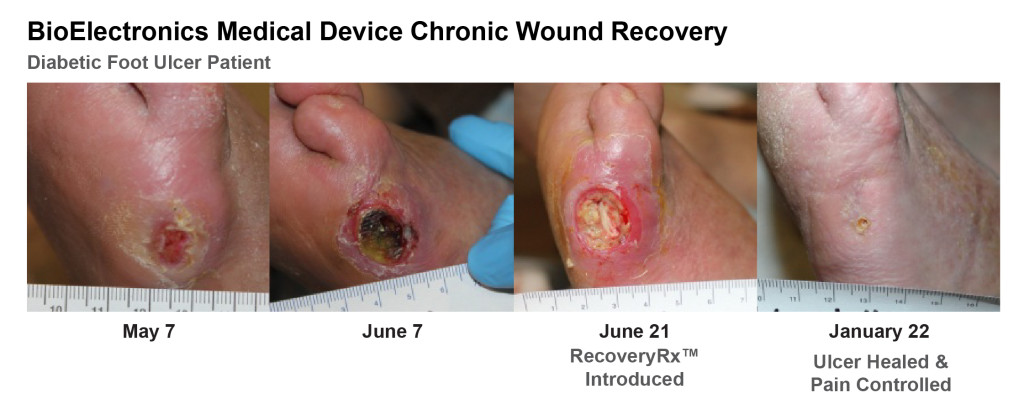BioElectronics Clinical Studies: Chronic Wounds
Introduction
Low-Level Pulsed Radiofrequency Fields and the Treatment of Soft-Tissue Injuries
The aim of this lecture is to outline the main physiological processes involved in the healing of wounds and to suggest a mechanism by which pulsed radiofrequency (RF) energy, or the currents induced in tissues by the application of that energy, may influence its course.
Emphasis is given to the part played by edema in inhibiting the processes of wound healing. Reference is made to the growing evidence that pulsed RF energy affects the time course of wound healing and the hypothesis is proposed that one possible mechanism by which pulsed RF energy accelerates wound healing is by reducing edema.
Pulsed radiofrequency electromagnetic field therapy is available in various forms. Extensive clinical research has been conducted with a large number of clinical publications for hard to heal and chronic wounds. Most research; however, has been done with devices that use relatively high power, are large and clinic based. These therapies have been shown to be effective, but due to the frequency of the applications (up to twice daily for 30 min) it has limited potential for widespread use.

RecoveryRx® technology is the miniaturization of the traditional large equipment used in hospitals and clinics. Advances in microelectronics have made it possible to deliver the clinically proven and superior extended duration therapy in small, convenient and cost-effective applications.
RecoveryRx® is applied to the wound, incorporating into the dressing or on top of the dressing for 24 hours per day. The radiofrequency electromagnetic field from RecoveryRx® passes through the dressing; therefore, the device does not need to be in direct contact with the skin. This makes for a simple application of this powerful technology, which not only promotes wound healing but also reduces chronic wound pain.
Published Case Series
In a case series of four patients who were treated with RecoveryRx® at Temple Foot and Ankle Clinic, Philadelphia, all the patients had long standing ulcers that had failed previous therapies. The study period was six weeks. Three patients had diabetic ulcers and one had a venous stasis ulcer. This case series has been published in the International Wound Journal.
Diabetic patient with Venous Stasis Ulcer had undergone compression therapy and no appreciable healing was seen. Compression therapy was continued along with RecoveryRx® therapy.

Diabetic patient with a right heel ulcer. Failed therapy included offloading, debridement and application of triple antibiotic ointment. After RecoveryRx® therapy was introduced ulcer healed in 3 weeks.

Diabetic patient with ulcer on right foot, previous failed therapy debridement, use of Promogran dressing. After RecoveryRx® therapy was introduced ulcer healed in 3 weeks.

All four patients healed after the introduction of RecoveryRx® therapy, two in 3 weeks and two patients healed in 8 weeks. The table below documents the rate of healing for the 4 patients in this study.
| Patient | Age | Location | Week 0 | Week 1 | Week 2 | Week 3 | Week 4 | Week 5 | Week 6 |
| 1 | 66 | right leg | 4 x 2.5 | 4 x 2.3 | 4 x 2 | 3 x 1.5 | 2 x 1.5 | 1 x 0.7 | 0.7 x 0.5 |
| 2 | 60 | right foot | 0.5 x 0.5 | 0.3 x0.3 | 0.2 x 0.1 | ulcer healed | |||
| 3 | 43 | left heel | 4 x 1 | 2 x 0.5 | 1 x 0.3 | ulcer healed | |||
| 4 | 74 | right heel | 2.5 x 1.75 | 2 X 2 | 2 X 1.5 | 1.7 X 0.7 | 1 X 1 | 1 X 0.5 | 1 X 0.5 |